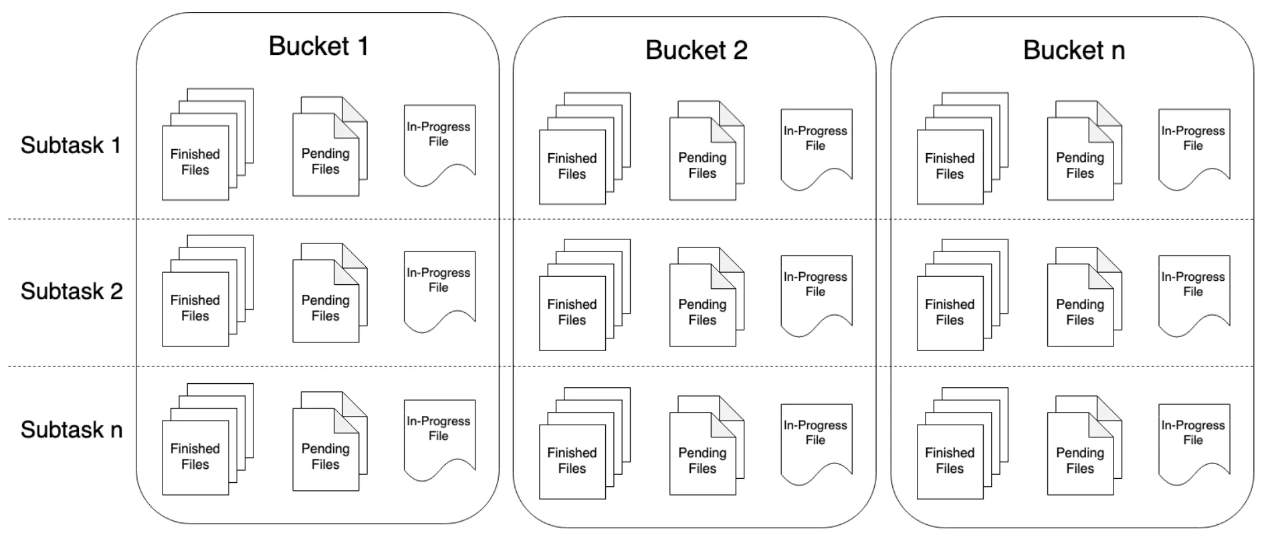7月7日,Flink 1.11 版本發佈,與 1.10 版本相比,1.11 版本最為顯著的一個改進是 Hive Integration 顯著增強,也就是真正意義上實現了基於 Hive 的流批一體。
本文用簡單的本地示例來體驗 Hive Streaming 的便利性並跟大家分享體驗的過程以及我的心得,希望對大家上手使用有所幫助。
添加相關依賴
測試集群上的 Hive 版本為 1.1.0,Hadoop 版本為 2.6.0,Kafka 版本為 1.0.1。
<properties>
<scala.bin.version>2.11</scala.bin.version>
<flink.version>1.11.0</flink.version>
<flink-shaded-hadoop.version>2.6.5-10.0</flink-shaded-hadoop.version>
<hive.version>1.1.0</hive.version>
</properties>
<dependencies>
<dependency>
<groupId>org.apache.flink</groupId>
<artifactId>flink-streaming-scala_${scala.bin.version}</artifactId>
<version>${flink.version}</version>
</dependency>
<dependency>
<groupId>org.apache.flink</groupId>
<artifactId>flink-clients_${scala.bin.version}</artifactId>
<version>${flink.version}</version>
</dependency>
<dependency>
<groupId>org.apache.flink</groupId>
<artifactId>flink-table-common</artifactId>
<version>${flink.version}</version>
</dependency>
<dependency>
<groupId>org.apache.flink</groupId>
<artifactId>flink-table-api-scala-bridge_${scala.bin.version}</artifactId>
<version>${flink.version}</version>
</dependency>
<dependency>
<groupId>org.apache.flink</groupId>
<artifactId>flink-table-planner-blink_${scala.bin.version}</artifactId>
<version>${flink.version}</version>
</dependency>
<dependency>
<groupId>org.apache.flink</groupId>
<artifactId>flink-connector-hive_${scala.bin.version}</artifactId>
<version>${flink.version}</version>
</dependency>
<dependency>
<groupId>org.apache.flink</groupId>
<artifactId>flink-sql-connector-kafka_${scala.bin.version}</artifactId>
<version>${flink.version}</version>
</dependency>
<dependency>
<groupId>org.apache.flink</groupId>
<artifactId>flink-json</artifactId>
<version>${flink.version}</version>
</dependency>
<dependency>
<groupId>org.apache.flink</groupId>
<artifactId>flink-shaded-hadoop-2-uber</artifactId>
<version>${flink-shaded-hadoop.version}</version>
</dependency>
<dependency>
<groupId>org.apache.hive</groupId>
<artifactId>hive-exec</artifactId>
<version>${hive.version}</version>
</dependency>另外,別忘了找到 hdfs-site.xml 和 hive-site.xml,並將其加入項目。
創建執行環境
Flink 1.11 的 Table/SQL API 中,FileSystem Connector 是靠增強版 StreamingFileSink 組件實現,在源碼中名為 StreamingFileWriter。我們知道,只有在 Checkpoint 成功時,StreamingFileSink 寫入的文件才會由 Pending 狀態變成 Finished 狀態,從而能夠安全地被下游讀取。所以,我們一定要打開 Checkpointing,並設定合理的間隔。

val streamEnv = StreamExecutionEnvironment.getExecutionEnvironment
streamEnv.setStreamTimeCharacteristic(TimeCharacteristic.EventTime)
streamEnv.setParallelism(3)
val tableEnvSettings = EnvironmentSettings.newInstance()
.useBlinkPlanner()
.inStreamingMode()
.build()
val tableEnv = StreamTableEnvironment.create(streamEnv, tableEnvSettings)
tableEnv.getConfig.getConfiguration.set(ExecutionCheckpointingOptions.CHECKPOINTING_MODE, CheckpointingMode.EXACTLY_ONCE)
tableEnv.getConfig.getConfiguration.set(ExecutionCheckpointingOptions.CHECKPOINTING_INTERVAL, Duration.ofSeconds(20))註冊 HiveCatalog
val catalogName = "my_catalog"
val catalog = new HiveCatalog(
catalogName, // catalog name
"default", // default database
"/Users/lmagic/develop", // Hive config (hive-site.xml) directory
"1.1.0" // Hive version
)
tableEnv.registerCatalog(catalogName, catalog)
tableEnv.useCatalog(catalogName)創建 Kafka 流表
Kafka Topic 中存儲的是 JSON 格式的埋點日誌,建表時用計算列生成事件時間與水印。1.11 版本 SQL Kafka Connector 的參數相比 1.10 版本有一定簡化。
tableEnv.executeSql("CREATE DATABASE IF NOT EXISTS stream_tmp")
tableEnv.executeSql("DROP TABLE IF EXISTS stream_tmp.analytics_access_log_kafka")
tableEnv.executeSql(
"""
|CREATE TABLE stream_tmp.analytics_access_log_kafka (
| ts BIGINT,
| userId BIGINT,
| eventType STRING,
| fromType STRING,
| columnType STRING,
| siteId BIGINT,
| grouponId BIGINT,
| partnerId BIGINT,
| merchandiseId BIGINT,
| procTime AS PROCTIME(),
| eventTime AS TO_TIMESTAMP(FROM_UNIXTIME(ts / 1000,'yyyy-MM-dd HH:mm:ss')),
| WATERMARK FOR eventTime AS eventTime - INTERVAL '15' SECOND
|) WITH (
| 'connector' = 'kafka',
| 'topic' = 'ods_analytics_access_log',
| 'properties.bootstrap.servers' = 'kafka110:9092,kafka111:9092,kafka112:9092'
| 'properties.group.id' = 'flink_hive_integration_exp_1',
| 'scan.startup.mode' = 'latest-offset',
| 'format' = 'json',
| 'json.fail-on-missing-field' = 'false',
| 'json.ignore-parse-errors' = 'true'
|)
""".stripMargin
)前面已經註冊了 HiveCatalog,故在 Hive 中可以觀察到創建的 Kafka 流表的元數據(注意該表並沒有事實上的列)。
hive> DESCRIBE FORMATTED stream_tmp.analytics_access_log_kafka;
OK
# col_name data_type comment
# Detailed Table Information
Database: stream_tmp
Owner: null
CreateTime: Wed Jul 15 18:25:09 CST 2020
LastAccessTime: UNKNOWN
Protect Mode: None
Retention: 0
Location: hdfs://sht-bdmq-cls/user/hive/warehouse/stream_tmp.db/analytics_access_log_kafka
Table Type: MANAGED_TABLE
Table Parameters:
flink.connector kafka
flink.format json
flink.json.fail-on-missing-field false
flink.json.ignore-parse-errors true
flink.properties.bootstrap.servers kafka110:9092,kafka111:9092,kafka112:9092
flink.properties.group.id flink_hive_integration_exp_1
flink.scan.startup.mode latest-offset
flink.schema.0.data-type BIGINT
flink.schema.0.name ts
flink.schema.1.data-type BIGINT
flink.schema.1.name userId
flink.schema.10.data-type TIMESTAMP(3)
flink.schema.10.expr TO_TIMESTAMP(FROM_UNIXTIME(`ts` / 1000, 'yyyy-MM-dd HH:mm:ss'))
flink.schema.10.name eventTime
flink.schema.2.data-type VARCHAR(2147483647)
flink.schema.2.name eventType
# 略......
flink.schema.9.data-type TIMESTAMP(3) NOT NULL
flink.schema.9.expr PROCTIME()
flink.schema.9.name procTime
flink.schema.watermark.0.rowtime eventTime
flink.schema.watermark.0.strategy.data-type TIMESTAMP(3)
flink.schema.watermark.0.strategy.expr `eventTime` - INTERVAL '15' SECOND
flink.topic ods_analytics_access_log
is_generic true
transient_lastDdlTime 1594808709
# Storage Information
SerDe Library: org.apache.hadoop.hive.serde2.lazy.LazySimpleSerDe
InputFormat: org.apache.hadoop.mapred.TextInputFormat
OutputFormat: org.apache.hadoop.hive.ql.io.IgnoreKeyTextOutputFormat
Compressed: No
Num Buckets: -1
Bucket Columns: []
Sort Columns: []
Storage Desc Params:
serialization.format 1
Time taken: 1.797 seconds, Fetched: 61 row(s)創建 Hive 表
Flink SQL 提供了兼容 HiveQL 風格的 DDL,指定 SqlDialect.HIVE 即可( DML 兼容還在開發中)。
為了方便觀察結果,以下的表採用了天/小時/分鐘的三級分區,實際應用中可以不用這樣細的粒度(10分鐘甚至1小時的分區可能更合適)。
tableEnv.getConfig.setSqlDialect(SqlDialect.HIVE)
tableEnv.executeSql("CREATE DATABASE IF NOT EXISTS hive_tmp")
tableEnv.executeSql("DROP TABLE IF EXISTS hive_tmp.analytics_access_log_hive")
tableEnv.executeSql(
"""
|CREATE TABLE hive_tmp.analytics_access_log_hive (
| ts BIGINT,
| user_id BIGINT,
| event_type STRING,
| from_type STRING,
| column_type STRING,
| site_id BIGINT,
| groupon_id BIGINT,
| partner_id BIGINT,
| merchandise_id BIGINT
|) PARTITIONED BY (
| ts_date STRING,
| ts_hour STRING,
| ts_minute STRING
|) STORED AS PARQUET
|TBLPROPERTIES (
| 'sink.partition-commit.trigger' = 'partition-time',
| 'sink.partition-commit.delay' = '1 min',
| 'sink.partition-commit.policy.kind' = 'metastore,success-file',
| 'partition.time-extractor.timestamp-pattern' = '$ts_date $ts_hour:$ts_minute:00'
|)
""".stripMargin
)Hive 表的參數複用了 SQL FileSystem Connector 的相關參數,與分區提交(Partition Commit)密切相關。僅就上面出現的4個參數簡單解釋一下。
- sink.partition-commit.trigger:觸發分區提交的時間特徵。默認為 processing-time,即處理時間,很顯然在有延遲的情況下,可能會造成數據分區錯亂。所以這裡使用 partition-time,即按照分區時間戳(即分區內數據對應的事件時間)來提交。
- partition.time-extractor.timestamp-pattern:分區時間戳的抽取格式。需要寫成 yyyy-MM-dd HH:mm:ss 的形式,並用 Hive 表中相應的分區字段做佔位符替換。顯然,Hive 表的分區字段值來自流表中定義好的事件時間,後面會看到。
- sink.partition-commit.delay:觸發分區提交的延遲。在時間特徵設為 partition-time 的情況下,當水印時間戳大於分區創建時間加上此延遲時,分區才會真正提交。此值最好與分區粒度相同,例如若 Hive 表按1小時分區,此參數可設為 1 h,若按 10 分鐘分區,可設為 10 min。
- sink.partition-commit.policy.kind:分區提交策略,可以理解為使分區對下游可見的附加操作。 metastore 表示更新 Hive Metastore 中的表元數據, success-file 則表示在分區內創建 _SUCCESS 標記文件。
當然,SQL FileSystem Connector 的功能並不限於此,還有很大自定義的空間(如可以自定義分區提交策略以合併小文件等)。具體可參見官方文檔。
流式寫入 Hive
注意將流表中的事件時間轉化為 Hive 的分區。
tableEnv.getConfig.setSqlDialect(SqlDialect.DEFAULT)
tableEnv.executeSql(
"""
|INSERT INTO hive_tmp.analytics_access_log_hive
|SELECT
| ts,userId,eventType,fromType,columnType,siteId,grouponId,partnerId,merchandiseId,
| DATE_FORMAT(eventTime,'yyyy-MM-dd'),
| DATE_FORMAT(eventTime,'HH'),
| DATE_FORMAT(eventTime,'mm')
|FROM stream_tmp.analytics_access_log_kafka
|WHERE merchandiseId > 0
""".stripMargin
)來觀察一下流式 Sink 的結果吧。

上文設定的 Checkpoint Interval 是 20 秒,可以看到,上圖中的數據文件恰好是以 20 秒的間隔寫入的。由於並行度為 3,所以每次寫入會生成 3 個文件。分區內所有數據寫入完畢後,會同時生成 _SUCCESS 文件。如果是正在寫入的分區,則會看到 .inprogress 文件。
通過 Hive 查詢一下,確定數據的時間無誤。
hive> SELECT from_unixtime(min(cast(ts / 1000 AS BIGINT))),from_unixtime(max(cast(ts / 1000 AS BIGINT)))
> FROM hive_tmp.analytics_access_log_hive
> WHERE ts_date = '2020-07-15' AND ts_hour = '23' AND ts_minute = '23';
OK
2020-07-15 23:23:00 2020-07-15 23:23:59
Time taken: 1.115 seconds, Fetched: 1 row(s)流式讀取 Hive
要將 Hive 表作為流式 Source,需要啟用 Dynamic Table Options,並通過 Table Hints 來指定 Hive 數據流的參數。以下是簡單地通過 Hive 計算商品 PV 的例子。
tableEnv.getConfig.getConfiguration.setBoolean(TableConfigOptions.TABLE_DYNAMIC_TABLE_OPTIONS_ENABLED, true)
val result = tableEnv.sqlQuery(
"""
|SELECT merchandise_id,count(1) AS pv
|FROM hive_tmp.analytics_access_log_hive
|/*+ OPTIONS(
| 'streaming-source.enable' = 'true',
| 'streaming-source.monitor-interval' = '1 min',
| 'streaming-source.consume-start-offset' = '2020-07-15 23:30:00'
|) */
|WHERE event_type = 'shtOpenGoodsDetail'
|AND ts_date >= '2020-07-15'
|GROUP BY merchandise_id
|ORDER BY pv DESC LIMIT 10
""".stripMargin
)
result.toRetractStream[Row].print().setParallelism(1)
streamEnv.execute()三個 Table Hint 參數的含義解釋如下。
- streaming-source.enable:設為 true,表示該 Hive 表可以作為 Source。
- streaming-source.monitor-interval:感知 Hive 表新增數據的週期,以上設為 1 分鐘。對於分區表而言,則是監控新分區的生成,以增量讀取數據。
- streaming-source.consume-start-offset:開始消費的時間戳,同樣需要寫成 yyyy-MM-dd HH:mm:ss 的形式。
更加具體的說明仍然可參見官方文檔。
最後,由於 SQL 語句中有 ORDER BY 和 LIMIT 邏輯,所以需要調用 toRetractStream() 方法轉化為回撤流,即可輸出結果。
The End
Flink 1.11 的 Hive Streaming 功能大大提高了 Hive 數倉的實時性,對 ETL 作業非常有利,同時還能夠滿足流式持續查詢的需求,具有一定的靈活性。
感興趣的同學也可以自己上手測試。